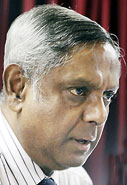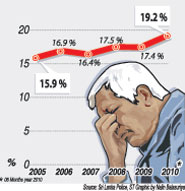The figures are down but a “worrying” trend seems to be taking shape with more elderly men and women hitting the depths of despair for which tragically they see no other way but taking their own lives.
Although Sri Lanka has quietly but surely lost its dubious reputation of being No. 1 in the world for suicides with its interventions, the increase in the numbers of the elderly (those over 60) thinking that they have no other recourse but to do self-harm needs to be looked at carefully, stresses Prof. Ravindra Fernando, Senior Professor of Forensic Medicine and Toxicology of the Colombo Medical Faculty.
In the first six months of 2010, according to police records, of the 2,023 who took their own lives, 390 were elders while in the 12 months of 2009, of 4,018 people who committed suicide, 701 were elders. (See graphic for rising trend)
The elderly too resorted to the same drastic ways as those in other age-categories, with the highest numbers taking their lives by swallowing insecticides and pesticides. The next biggest group fell into the hanging category, the police records indicate.
 |
| Prof. Ravindra
Fernando |
As World Suicide Prevention Day was celebrated yesterday (September 10), Prof. Fernando urges that with an aging population, Sri Lanka needs to look for ways to stymie this trend of the elderly taking their own lives, while lauding the fact that the country which reached a peak for suicides in 1995 with a sadly high 48.7 per 100,000 has now been able to bring it down to 20.09 per 100,000 in 2009.
“There is much cause for concern,” says Prof. Fernando, explaining that the elderly may resort to self-harm due to chronic and painful illnesses such as arthritis and cancer leading to frustration, neglect by family members and also depression. “They may then see daily living as a problem.”
Sometimes family members, even though they may want to look after the elderly, may not have the wherewithal or the resources to do so, Prof. Fernando points out.
Elderly suicides should be studied and steps taken to prevent them, he says, confident that Sri Lanka is capable of doing so in the light of the “success story” since 1995.
Suicide rates were cut through multifactorial interventions, it is learnt, including the banning of the importation of highly toxic pesticides as well as the improvement in the hospital management of poisoning cases.
Hospitals being better equipped and having the necessary medication while doctors being better trained in the management of patients who come in with poisoning have led to many lives being saved, he says, adding that awareness campaigns carried out by both governmental and non-governmental organizations have also helped.
World Suicide Prevention Day promotes worldwide commitment and action to prevent suicides, according to the World Health Organization (WHO) which states that on average almost 3,000 people commit suicide daily across the globe. For every person who completes a suicide, 20 or more may attempt to end their lives.
At the global level, awareness needs to be raised that suicide is a major preventable cause of premature death, the WHO states. ‘Preventing suicide in multicultural societies’, being the theme this year, Prof. Fernando echoes the International Association for Suicide Prevention (IASP), urging that such societies require cultural sensitivity in all suicide prevention efforts.
However, a common mistake is to treat culture as something objective that explains differences. When we find differences between cultural groups in a society, e.g. suicide rates and risk factors, we tend to explain these in terms of cultural differences. This can, however, conceal the real reasons for differences that may or may not have something to do with culture at all, he says, quoting the IASP.
The examples of other factors that are cited as being important are unemployment, poverty, oppression, marginalization, stigmatization or racism.
Suicide prevention in multicultural societies needs to be targeted as a multidisciplinary effort. People who can contribute to suicide prevention include, for instance, health and social care professionals, researchers, teachers, police, journalists, religious leaders, cultural leaders, politicians and community leaders, volunteers and relatives and friends affected by suicidal behaviour. People also tend to open up to bartenders, hairdressers and taxi drivers, among others, states IASP.
That’s why, stresses Prof. Fernando, suicide prevention is everybody's business. |




